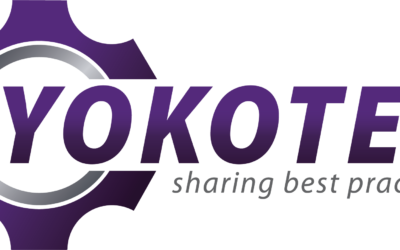Building a culture of problem solving. Practices of Continuous Improvement.
What is my role as a leader? What can I do to successfully implement a sustainable problem-solving culture in my company?
Most problems should be solved at the operational level by workers within this level. Larger, complex problems of a strategic nature should be addressed by senior management. However, the important thing is that regardless of whether the problem is small or strategic and how and who solves the problem, the tools, principles and methods are exactly the same.
Working with Toyota for several years I had the opportunity to learn and experience with my team how complex it is to implement a problem solving culture for 4700 employees. My CEO in Toyota emphasized: “To solve problems in the company we have to give our employees the tools. However, for them to be able to solve problems effectively, we must first create an environment in which they want to use these tools. The best way to start creating this environment is to be a lean leader for your employees and team members. We should also accept the truth that “most of us (managers/leaders) have done a lot to avoid creating a culture of problem solving. Think about whether you will answer any of the questions below in the affirmative:
- Are there too many e-mails sent in your organization (“bouncing e-mails”)? This is a real sign that your company lacks standardization, visual management and problem solving.
- Do employees take notes during meetings and are they generally frustrating and badly conducted? This is because meetings and problem solving use techniques from the 20th century… and we have the expectations of clients and competition for the 21st century.
- Has it happened to you in the last 30 days to say you’ ll take care of the problem yourself or find a solution for it?
- Can you say that the communication between the divisions / departments / functions was far from optimal when it came to exchanging information, openly sharing ideas, thoughts, concerns, or there was no atmosphere of respect and trust?
- In the last 30 days, have you attended a meeting on a specific problem in the area of e.g. quality where there was a discussion on the topic; not filling in the quality control charter by line leaders or changes? If yes, did you visualize the problem on the board/ paper? Here you can ask a number of other questions about enumerating the possible causes, the business impact(s), identifying the owner of the topic or who attended the meeting, gemba and understanding what happened. In any case, a negative answer is an indication that the culture of problem solving is questionable. It means that we have done a lot in our daily work not to create a culture of problem solving. Shock, the main problem is me! Well, we know what should happen next – we must eliminate the root cause and implement new standards. Of course, one solution is to dismiss yourself…but there are other, alternative solutions. One of them is to understand our own role and change our approach to employees when a problem arises. That’s what was the key/breakthrough moment in practicing Toyota Way.
- Does every leader, foreman or manager have a clear picture of what role do they play when a problem arises? Did you know that “the role of a real team or group leader or manager in Toyota is not to personally solve problems when they arise”?
In my opinion, many of us have been educated, experienced, have ingrained habits and behaviors that are not conducive to creating an open culture of problem solving at work. Therefore, for us to succeed, we have to go a long way to change our habits, opinions and perceptions about how we approach problem solving. Unfortunately, I will disappoint those who think that a few days’ training in A3 problem solving is enough. Unfortunately, changes of habits cannot be done during the training in the conference room!
Of course, the implementation of the A3 (Practical Problem Solving) method is extremely important and I have seen in dozens of companies with whom I have worked, how great the effects of using it are. However, now I would like to focus on the role of a leader/manager in a situation when a problem arises.
Step one – Start with yourself.
It doesn’t matter if you’re a director or a line leader. Building a culture of identifying and solving problems starts with your approach to problems and challenges at work. Remember, you don’t have to change them, but yourself. As you understand it, you’ll be ready to take the next steps, the first of which will be self-reflection. It is defined by the Japanese word hansei and allows you to determine what you need to do to be a better leader and example for others for the next day. It is worth exploring the subject of hansei, reading good examples of others, understanding what it means. Hansei is a key feature of managers at Toyota. Self-reflection requires sincerity, honesty and humility from time to time. If you would like to be a leader of lean sensei in the future, concentrate on practicing hansei.
For those who would like to know a little more, I would add that the leader of lean sensei acts in accordance with the following four values: practicing hansei, showing respect for others, building trust and practicing mendomi – building relationships through empathy. Once a month, each leader, from team foreman/team leader/line leader upwards, attended a meeting with their supervisor about their own development program in the hansei sensei. If you would like me to raise the issue of reaching the skills/lean level of a sensei leader I invite you to contact me.
Step two – Declare officially your commitment in building a culture of problem solving.
In building a culture of problem-solving and using tools to support it, doubts often arise as to what kind of problems to pay attention to, what type of problems, large or small, and in which cases to use tools such as A3, full or shortened version? Generally, based on practice, we can say that:
- Micro and mini problems require the same skills and competences, but not necessarily using the A3 tool.
- Medium and large problems require both skills and tools (full A3 methodology).
- Strategic issues similar to the previous ones.
Most of you have to face smaller and medium problems. It is often up to you whether the problem is considered large or small. When deciding what kind of problem it is, take into account the following elements:
- Its frequency/repeatability.
- The scale of impact on business.
- The cost of its repair/removal.
All too often when a problem arises and the team that has just, almost a day before, solemnly declared its commitment to the “CD Program”, tools, methodologies, competences, values and principles, starts to solve the problem in the old style. Unfortunately, a return to the wrong habits happens to everyone. We must remember about a very important principle that accompanies and supports change: “Do not expect perfection from others and from yourself, expect progress”.
Below I have listed a few examples of the various problems where the A3 approach was necessary and produced results that often exceeded expectations:
- The company’s generating waste. It also starts to have problems with liquidity. We must act quickly to improve liquidity and reduce waste.
- The company makes small profits, which are not satisfactory. The company’s profitability should be much higher. Numerous projects implemented at a waste are also a problem.
- The final quality is delivered to the customer at a very high level. Unfortunately, the costs of rework, internal control, expensive additional quality checks, repainting, etc. are too high.
- There is no effective cooperation between sales, planning and production.
- The design team is inefficient. Preparing their projects takes too much time, is too expensive, and there is a lack of good communication with the team.
- Before the client audits we work like crazy for 24 hours so that everything is prepared according to the standard expected by the client.
- Not all line leaders fill in/apply quality control cards as agreed.
- We often deliver our customers’ orders with delays.
- We have employees who do not perform 5S before the end of their shift.
- Too many people in the Company use sick notes, many seem “suspicious”.
- The level of turnover of newly recruited staff in the first three months of employment is too high and unacceptable.
The list of problems/challenges may actually be endless. In solving the above mentioned problems, it is most appropriate to use lean solutions, and the right lean culture will be very helpful, because the tools alone are not enough to achieve success. Everyone in the problems listed can (and has) been addressed using the A3 methodology. Each of them, even of the largest size (taking into account the scale and impact on the company’s operations) is no more serious than using the method of solving it and the people themselves who are trying to solve it. It is also important that the problem was not the fact that employees did not fill out quality control cards or that the company generated losses every month. These were the consequences. This is the thinking that Toyota taught us and according to this approach you have to get to the heart of the problem and understand the cause.
Step three – Engage and convert problematic employees/operators.
Starting with A3 and solving the problem, the question is who should we engage in a kick-off meeting? Involve those operators, team leaders, specialists or managers who directly influence the process. Go to a gemba, a “crime scene”. No less important, if not the most important, is to involve those employees who may be “slowing down” or even “destroyers” of the new standard/solution. In other words, engage those who may be the root cause or one of the key causes of the problem. Omniscient, lazy, reluctant, questioning whether those who have a recipe for what they wouldn’t do if they were the boss of the company – all these employees are extremely important in overcoming challenges and solving problems.
Toyota has taught me that many of the employees’ unwanted behaviour is a worrying signal which is send to the management. Often it is a kind of SOS, a cry for help when an employee feels they are not valued, feels demotivated, has ideas, but cannot present them, needs someone to choose them. In short, these “troubled” employees often undergo rapid transformation and become inspiring lean leaders for others. In Toyota, one of my tasks was to identify “troublesome” employees and make them “stars”. I can honestly say that in most cases involving such an employee in the implementation work, involving them and working on them to become lean leaders gives really incredible results. I’ve experienced this many times. It is not an easy task, but it is extremely rewarding to see how such an employee develops in the organization. So remember, if you want to solve problems on production, mix leaders/employees who you see as good and those who create problems into the problem solving team. In 90% of cases you will get unexpectedly positive results.
Step four – Teach them to fish when they’re hungry.
Another important element of the Toyota philosophy (Toyota Way). If there is a problem on your shift, think about your role. Remember what I wrote earlier – if you want to create a culture of problem solving, start with yourself. For example, if a health and safety problem arises that brings with it risks to the employee, or a serious and financially costly quality problem, you should react immediately and make the right decisions. In other cases, you should create an environment and conditions in which your team can solve the problem. You will play a catalyst, moderator and coach role in this process.As a lean leader, you should use the event as an opportunity to “teach” employees to be independent. Do not treat an action as a “firefighting” that is often repeated when a problem/challenge arises. The fact that it is not you who will solve the problem should not be treated by you as an inability to make decisions. Your strength (not an ego problem) is to be a leader who supports employees in the way they “learn to fish”.
If you are strongly involved in solving problems in such a way that you try to solve them, control, intensively monitor actions, advise, it means that employees escalate problems to your level – you are too busy and employees are not competent. But most often it is you who have led to this situation, because your teammates “react”/they are in the environment you create for them. However, creating an environment for asking questions, going to the gemba, sharing problems rather than hiding them, searching for root causes, visualizing problems on boards (or paper) will give you more time for other things. This will reduce the phenomenon of escalation of problems to a higher level in the organization. Escalation of problems by employees to higher levels is a result of inappropriate management style and manager’s failure.
I will write next time about the Pyramid of escalation of Toyota’s problems and practical solutions in solving them in organizations.
Step five – Strengthen.
Use problem solving to (develop and strengthen the following areas):
- Build/increase the efficiency of the team/teams (The fourth stage of building effective teams is “achieved results/efficiency”).
- Improve communication within the organisation and with teams within your and other areas/functions.
- Take the opportunity to test different visual management solutions. Use images, graphics, information on boards to communicate what is happening in A3 project to different interested employees.
- Build trust and show respect. If you are a lean leader this is a critical and crucial moment to show what real situational lean management means in practice.
Step six – Celebrate.
At Toyota, celebration is an integral part of building a culture of problem solving. Celebration is just as important as defining problems, preparing an ishikawa map, solving a problem or introducing and consolidating new standards. Sharing success with employees is extremely important and it is important for them to feel that they were part of it and it is up to them and their work to achieve the goal/solution. Celebrating means, above all, saying “thank you”. – words and gestures are important.
In my YouTube videos and articles, I talked a lot about celebrating success at work. Work is a very important part of your life and your team members, your employees. So experience these moments with them. Thank them even if not everything goes according to plan. It is important for your employees to feel that their efforts are appreciated. Use simple gestures: order a pizza, invite the employee to lunch (even having lunch together in the company’s canteen and having a conversation is of great value. Buy a T-shirt or cap that identifies your employees/team that solves the problem. Simple actions and gestures are at least as important as the job itself, salary or bonus.

How do you feel about building a culture of problem solving?
Of course, these are not all possible actions or solutions. I have selected a few, in my opinion important ones, which turned out to be crucial for success in the recently implemented Continuous Improvement Programmes. Question your role and what you do, solemnly declare your commitment to building a culture of problem-solving, engage and convert your employees, strengthen and celebrate. Write what you think about it and whether the solutions have worked for you.



